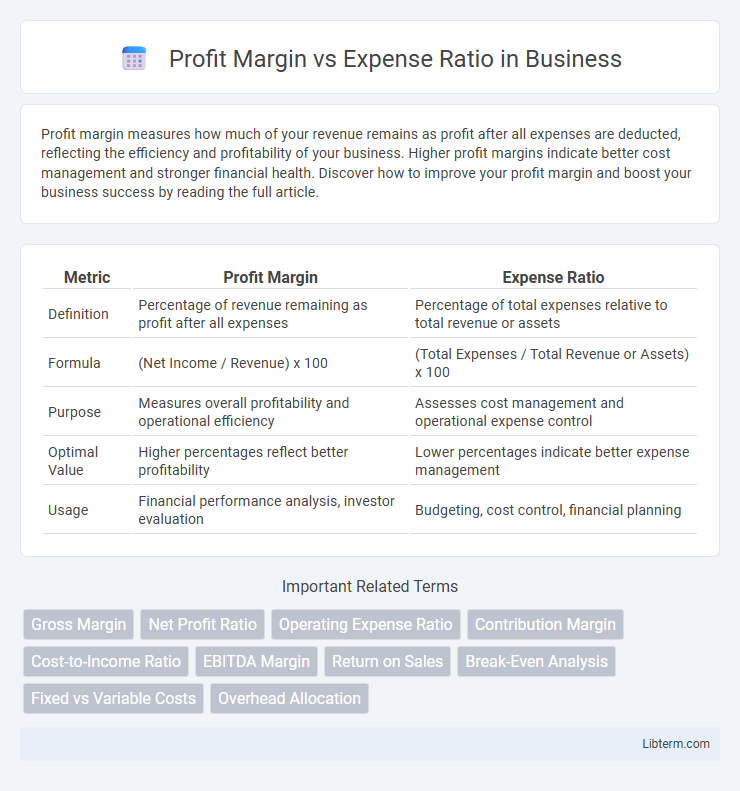Profit margin measures how much of your revenue remains as profit after all expenses are deducted, reflecting the efficiency and profitability of your business. Higher profit margins indicate better cost management and stronger financial health. Discover how to improve your profit margin and boost your business success by reading the full article.
Table of Comparison
| Metric | Profit Margin | Expense Ratio |
|---|---|---|
| Definition | Percentage of revenue remaining as profit after all expenses | Percentage of total expenses relative to total revenue or assets |
| Formula | (Net Income / Revenue) x 100 | (Total Expenses / Total Revenue or Assets) x 100 |
| Purpose | Measures overall profitability and operational efficiency | Assesses cost management and operational expense control |
| Optimal Value | Higher percentages reflect better profitability | Lower percentages indicate better expense management |
| Usage | Financial performance analysis, investor evaluation | Budgeting, cost control, financial planning |
Understanding Profit Margin: A Quick Overview
Profit margin measures the percentage of revenue that remains as profit after all expenses are deducted, indicating a company's financial health and operational efficiency. A higher profit margin signifies better control over costs and pricing strategies, often leading to increased shareholder value. Understanding profit margin helps businesses assess profitability compared to expense ratio, which focuses solely on operational costs relative to revenue.
Defining Expense Ratio in Business Finance
The expense ratio in business finance measures the proportion of total expenses to total revenue, reflecting operational efficiency and cost management. It is a critical metric for assessing how effectively a company controls its costs relative to its income, directly impacting overall profitability. A lower expense ratio indicates better expense control, enhancing the potential for higher profit margins.
Key Differences Between Profit Margin and Expense Ratio
Profit margin measures the percentage of revenue remaining as profit after all expenses are deducted, indicating overall profitability, while the expense ratio represents the proportion of total expenses relative to revenue, focusing solely on cost efficiency. Profit margin provides insight into a company's ability to generate earnings above costs, whereas the expense ratio highlights how well a company controls its operating expenses. Key differences include their impact on financial analysis: profit margin reflects net performance, and expense ratio emphasizes expense management.
Importance of Tracking Profit Margin
Tracking profit margin is essential for assessing a company's financial health and operational efficiency by revealing how much revenue translates into actual profit. Unlike the expense ratio, which highlights the proportion of expenses relative to revenue, profit margin offers a comprehensive view of profitability and cost management effectiveness. Consistent monitoring of profit margin helps businesses optimize pricing strategies, control costs, and improve overall financial performance.
Why Expense Ratio Matters for Companies
Expense ratio directly impacts a company's profitability by measuring the proportion of operating expenses relative to revenue, making it a critical indicator of cost efficiency. A lower expense ratio signifies better expense management, allowing higher profit margins and enhancing the company's competitive advantage. Monitoring and optimizing expense ratios enable companies to allocate resources more effectively, support sustainable growth, and improve overall financial health.
How to Calculate Profit Margin Effectively
To calculate profit margin effectively, divide net profit by total revenue and multiply by 100 to express it as a percentage, highlighting the company's profitability relative to sales. Comparing profit margin to expense ratio, which measures operating expenses as a percentage of revenue, helps identify efficiency in managing costs versus generating profit. Monitoring these key financial metrics enables businesses to optimize pricing strategies and control expenses for improved financial performance.
Calculating Expense Ratio: Step-by-Step Guide
Calculating the expense ratio involves dividing total operating expenses by the fund's average net assets, then multiplying by 100 to express it as a percentage. This ratio measures the percentage of assets used for administrative and operational costs, crucial for evaluating fund efficiency. Accurate calculation requires detailed financial statements outlining all incurred expenses and asset valuations over the relevant period.
Impact of High Expense Ratio on Profitability
A high expense ratio directly reduces profitability by increasing the proportion of costs relative to total revenue, thereby shrinking the profit margin. Companies experiencing elevated expense ratios often face tighter net margins, limiting their capacity to reinvest in growth or distribute dividends. Effective cost management strategies are essential to maintain healthy profit margins and ensure sustainable financial performance.
Strategies to Improve Profit Margin and Reduce Expense Ratio
Improving profit margin involves strategies such as increasing revenue through targeted marketing, optimizing pricing models, and enhancing product value to boost sales without proportionally raising costs. Reducing expense ratio requires strict cost control measures including streamlining operations, negotiating better supplier contracts, and leveraging automation to decrease overhead expenses. Businesses that simultaneously focus on revenue growth while cutting unnecessary costs achieve a healthier balance between profit margin and expense ratio, driving sustainable financial performance.
Profit Margin vs Expense Ratio: Choosing the Right Metric for Growth
Profit Margin measures the percentage of revenue that remains as profit after all expenses, highlighting overall profitability, while Expense Ratio evaluates operating costs as a proportion of total revenue, emphasizing cost efficiency. Selecting the right metric depends on business goals: Profit Margin suits companies aiming for sustainable growth through profitability, whereas Expense Ratio is critical for managers prioritizing expense control and operational efficiency. Understanding both metrics' impact on financial health supports informed strategic decisions for scalable growth.
Profit Margin Infographic

 libterm.com
libterm.com